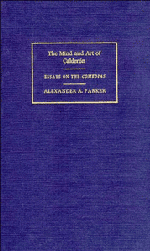Book contents
- Frontmatter
- Contents
- Author's preface
- Editor's preface
- Introduction
- I Stylistic and dramatic craftsmanship
- 1 Principles of interpretation
- 2 From metaphor to symbol
- 3 The dramatic structure of El alcalde de Zalamea
- 4 ‘Poetic truth’ in the shaping of plots
- 5 The Coriolanus theme: Las armas de la hermosura
- II From experience to myth
- III The tensions of social life
- IV The tensions of public life
- V From symbol to myth
- Epilogue
- Notes
- Index
3 - The dramatic structure of El alcalde de Zalamea
Published online by Cambridge University Press: 05 February 2012
- Frontmatter
- Contents
- Author's preface
- Editor's preface
- Introduction
- I Stylistic and dramatic craftsmanship
- 1 Principles of interpretation
- 2 From metaphor to symbol
- 3 The dramatic structure of El alcalde de Zalamea
- 4 ‘Poetic truth’ in the shaping of plots
- 5 The Coriolanus theme: Las armas de la hermosura
- II From experience to myth
- III The tensions of social life
- IV The tensions of public life
- V From symbol to myth
- Epilogue
- Notes
- Index
Summary
The claim that Calderón's method of constructing a plot was a disciplined and orderly one, where symmetry and regularity seem to follow self-imposed rules to the detriment of inspiration (as has been generally held) can be very clearly exemplified from El Alcalde de Zalamea, generally thought to have been written between 1642 and 1644. The first date marks the end of Calderón's military service in the Revolt of Catalonia, which would have given him experience of military life on campaign; the second date was 1644, when it became apparent that the war with Portugal was already lost. The play is set during an earlier campaign against Portugal, when in 1580 Philip II supported his claim to the Portuguese accession with an invading army. The episode dramatised in the play is said to have taken place on the march of one regiment to Lisbon. This play is not a record of an actual event, nor are the details of the march or of the military command accurate. There is no reason why the plot should have been connected with Portugal other than Portugal's expulsion of the Spanish garrisons in December 1640 and the declaration of a state of war, although no campaign followed.
Calderon's fondness for symmetry has been noted in connection with his versification, especially when his plays are libretti. This symmetry can become elaborate in the court plays of his middle period and old age, as also in his autos sacramentales.
- Type
- Chapter
- Information
- The Mind and Art of CalderónEssays on the Comedias, pp. 42 - 50Publisher: Cambridge University PressPrint publication year: 1989

